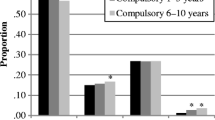Abstract
Whether local marriage market conditions shape marriage behavior is a central social demographic question. Most work on this subject, however, focuses on one type of market condition—sex ratios— and on a single outcome—marital timing or sorting. We examine the impact of local marriage markets’ educational composition on educational assortative mating and on how sorting varies with age. We estimate a discrete-time competing-risks model of educational sorting outcomes, using individual data from the NLSY and community descriptors aggregated from census microdata. Results show that residents of educationally less favorable marriage markets are more likely to marry down on education, and that (for women) their chance of doing so increases with age more than for residents of more favorable markets.
Similar content being viewed by others
References
Akers, D.S. 1967. “On Measuring the Marriage Squeeze.” Demography 4:907–24.
Allison, P.D. 1982. “Discrete-Time Methods for the Analysis of Event Histories.” Pp. 61–98 in Sociological Methodology 1982, edited by K. Keinhardt. San Francisco: Jossey-Bass.
— 1984. Event History Analysis. Beverly Hill: Sage.
Blackwell, D.L. 1998. “Marital Homogamy in the United States: The Influence of Individual and Paternal Education.” Social Science Research 27:159–88.
Blau, P.M. 1977. Inequality and Heterogeneity. New York: Free Press.
Blau, P.M., T.C. Blum, and J.E. Schwartz. 1982. “Heterogeneity and Intermarriage.” American Sociological Review 47:45–62.
Blau, P.M. and J.E. Schwartz. 1984. Crosscutting Social Circles. New York: Academic Press.
Buss, D.M. and M. Barnes. 1986. “Preferences in Human Mate Selection.” Journal of Personality and Social Psychology 50:559–70.
England, P. and G. Farkas. 1986. Households, Employment, and Gender. New York: Aldine.
Fossett, M.A. and K.J. Kiecolt. 1991. “A Methodological Review of the Sex Ratio: Alternatives for Comparative Research.” Journal of Marriage and the Family 53:941–57.
—— 1993. “Mate Availability and Family Structure Among African Americans in U.S. Metropolitan Areas.” Journal of Marriage and the Family 55:288–302.
Goldman, N., C.F. Westoff, and C. Hammerslough. 1984. “Demography of the Marriage Market in the United States.” Population Index 50:5–25.
Goldscheider, F.K. and J. DaVanzo. 1989. “Pathways to Independent Living in Early Adulthood: Marriage, Semiautonomy, and Premarital Residential Independence.” Demography 26:597–614.
Hachen, D.S., Jr. 1988. “The Competing Risks Model: A Method for Analyzing Processes With Multiple Types of Events.” Sociological Methods and Research 17:21–54.
Howard, J.A., P.A. Blumenstein, and P. Schwartz. 1987. “Social or Evolutionary Theories? Some Observations on Preferences in Human Mate Selection.” Journal of Personality and Social Psychology 53:194–200.
Kalmijn, M. 1991a. “Status Homogamy in the United States.” American Journal of Sociology 97:496–523.
— 1991b. “Shifting Boundaries: Trends in Religious and Educational Homogamy.” American Sociological Review 56:786–800.
— 1993. “Trends in Black/White Intermarriage.” Social Forces 72:119–46.
— 1998. “Intermarriage and Homogamy: Causes, Patterns, Trends.” Annual Review of Sociology 24:395–421.
Kennedy, R.J.R. 1943. “Premarital Residential Propinquity and Ethnic Endogamy.” American Journal of Sociology 48:580–84.
Landis, P.H. and K.H. Day. 1945. “Education as a Factor in Mate Selection.” American Sociological Review 10:558–60.
Lichter, D.T. 1990. “Delayed Marriage, Marital Homogamy, and the Mate Selection Process Among White Women.” Social Science Quarterly 71:802–11.
Lichter, D.T., R.N. Anderson, and M.D. Hayward. 1995. “Marriage Markets and Marital Choice.” Journal of Family Issues 16:412–31.
Lichter, D.T., F.B. LeClere, and D.K. McLaughlin. 1991. “Local Marriage Markets and the Marital Behavior of Black and White Women.” American Journal of Sociology 96:843–67.
Lichter, D.T., D.K. McLaughlin, G. Kephart, and D.J. Landry. 1992. “Race and the Retreat From Marriage: A Shortage of Marriageable Men?“ American Sociological Review 57:781–99.
Lloyd, K.M. and S.J. South. 1996. “Contextual Influences on Young Men’s Transition to First Marriage.” Social Forces 74:1097–119.
Mare, R.D. 1991. “Five Decades of Educational Assortative Mating.” American Sociological Review 56:15–32.
Marini, M.M. 1985. “Determinants of the Timing of Adult Role Entry.” Social Science Research 14:309–50.
Michael, R.T. and N.B. Tuma. 1985. “Entry Into Marriage and Parenthood by Young Men and Women: The Influence of Family Background.” Demography 22:515–44.
Muhsam, H.V. 1974. “The Marriage Squeeze.” Demography 11:291–99.
Oppenheimer, V.K. 1988. “A Theory of Marriage Timing.” American Journal of Sociology 94:563–91.
Pullum, T.W. and A. Peri. 1997. “The Multivariate Analysis of Homogamy.” Presented at the annual meetings of the Population Association of America, Washington, DC.
Qian, Z. and S.H. Preston. 1993. “Changes in American Marriage, 1972 to 1987: Availability and Forces of Attraction by Age and Education.” American Sociological Review 58:482–95.
Schoen, R. 1983. “Measuring the Tightness of the Marriage Squeeze.” Demography 20:62–78.
— 1986. “A Methodological Analysis of Intergroup Marriage.” Sociological Methodology 15:49–78.
Schoen, R. and J.R. Kluegel. 1988. “The Widening Gap in Black and White Marriage Rates: The Impact of Population Composition and Differential Marriage Propensities.” American Sociological Review 53:895–907.
Schoen, R. and J. Wooldredge. 1989. “Marriage Choices in North Carolina and Virginia, 1969–71 and 1979–81.” Journal of Marriage and the Family 51:465–81.
Schoen, R., J. Wooldredge, and B. Thomas. 1989. “Ethnic and Educational Effects on Marriage Choice.” Social Sciences Quarterly 70:617–30.
South, S.J. 1991. “Sociodemographic Differentials in Mate Selection Preferences.” Journal of Marriage and the Family 53:928–40.
South, S.J. and K.M. Lloyd. 1992. “Marriage Opportunities and Family Formation: Further Implications of Imbalanced Sex Ratios.” Journal of Marriage and the Family 54:440–51.
Wilson, W.J. and K.M. Neckerman. 1986. “Poverty and Family Structure: The Widening Gap Between Evidences and Public Policy Issues.” Pp. 232–59 in Fighting Poverty: What Works and What Doesn’t, edited by S.H. Danziger and D.H. Weinberg. Cambridge: Harvard University Press.
Yamaguchi, K. 1991. Event History Analysis. Newbury Park, CA: Sage.
Author information
Authors and Affiliations
Corresponding author
Additional information
We wish to thank Ken Bailey, Rob Mare, Bill Mason, Michael Seltzer, Ken Sokoloff, and the Demography reviewers and editors for helpful comments on earlier versions of this paper.
Rights and permissions
About this article
Cite this article
Lewis, S.K., Oppenheimer, V.K. Educational assortative mating across marriage markets: Nonhispanic whites in the United States. Demography 37, 29–40 (2000). https://doi.org/10.2307/2648094
Issue Date:
DOI: https://doi.org/10.2307/2648094




